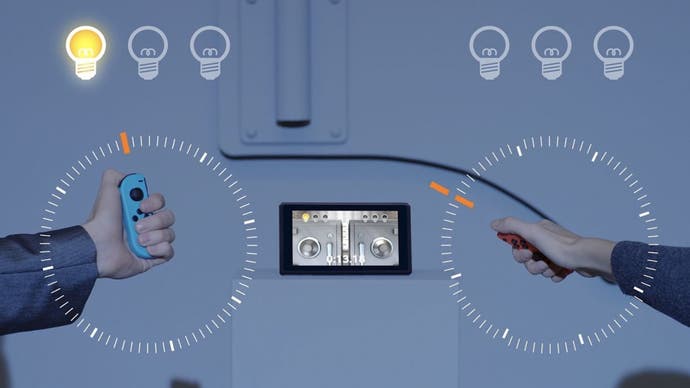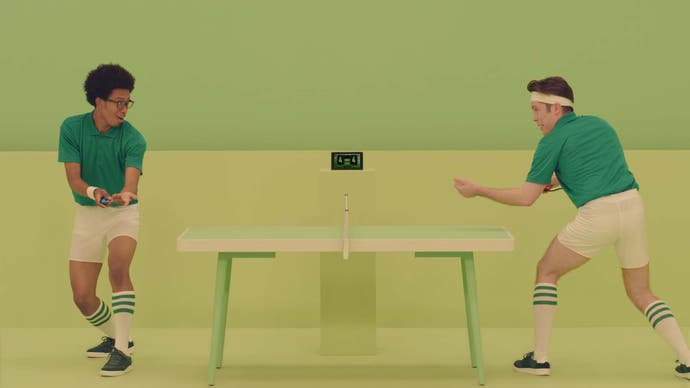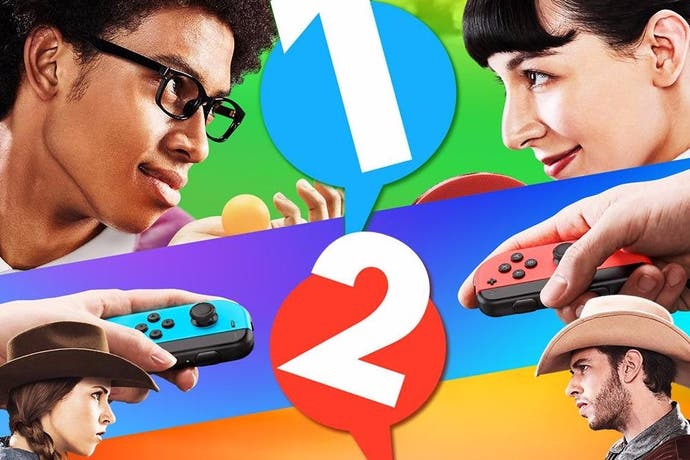1-2-Switch review
Pick up and play.
In hopeful pitches delivered to panels of drab-suited, stern-mouthed men, game-makers will refer to their games as being 'platform agnostic'. It's a way to make a game more attractive to publishers; the fewer features unique to a particular console a game utilises, the farther it can travel and the greater the potential audience. This commercial incentive has flattened video game design in a sense. Most game-makers want the technology on which a video game is built to be as invisible as paper is to books.
Nintendo has always had a fundamentally different perspective. For Shigeru Miyamoto, innovation in video game design stems from technological foibles and idiosyncrasies as much as anything else. The tactile joy of scratching out the answers to sums in Dr Kawashima's Brain Training is only made possible via the Nintendo DS touch screen. Those joyous games of multiplayer hide-and-seek in Nintendo Land are only made possible by the Wii-U's supporting, clandestine screen. The era-defining wonder of swinging a Wii controller in order to bat back a tennis ball in Wii Sports was only possible due to that remote control. Focusing R&D on merely improving frame rates and polygon counts is, for Nintendo, a gross misdirection of effort. Technology is not the blank, identikit canvas onto which games are painted. It is the topography that defines what kinds of play are possible.

1-2-Switch is, like Wii Sports, Nintendo Land and WarioWare before it, a game that sketches out the boundaries of playful possibility on Nintendo's freshest console (though unlike Wii Sports and Nintendo Land, 1-2 Switch is sold separately). It presents 28 minigames, each one interrogating the hardware's features in different ways, groping around to find what's possible on this slab of plastic and glass, with its weirdo detachable bits. It is the antithesis to platform agnosticism; 1-2-Switch could only exist in this moment, on this machine.
Take Telephone, for example, the first game in the suite, and arguably the best. After sliding the two Joy-Con controllers from their snug housing at the sides of the screen, each player sits their controller on the floor in front of them. You then wait, till the 'phone' rings. The winner is the first player to pick up their controller and bark "Hello" into its microphone. Peril is added (and authenticity somewhat undermined) by the fact that you must only pick-up when you hear the correct ring. Answer a 'ding-a-ling' when you're waiting for a 'brrrrring', say, and you're immediately disqualified. The minigame elegantly makes use of the Switch's various hardware quirks.
Like all of the other games in the collection, 1-2 Switch also reveals Nintendo's understanding that, when it comes to local multiplayer games, the fun is often found, not on the screen, but in your opponent's eyes. In almost every instance, the game implores you to look at each other. In Samurai Training, for example, one player holds the Joy-Con over their head, as if ready to bring a sword down. The other player must clasp their hands together in order to 'catch' the invisible sword at the correct moment, and in doing so survive to the next round. The game takes place, not on the screen, but in the reading of each other's flinches and fake-outs. Like Johann Sebastian Joust, indisputably the greatest tech-facilitated parlour game of the past decade, the hardware is fundamental, but also manages to get out of the way to allow for the richer, more satisfying interplay of human intimacy.

The screen cannot quite be dispensed with entirely, however. Hover over a minigame and, after a couple of seconds, a slickly produced explainer video plays out. While most of the games are easily understood, you'll need to watch these snippets the first time through, an interruption that breaks the flow of excitement in the room - at least until every player is familiar with the 'how to' of every game. The structure is, beyond this, pleasingly straightforward. To begin with you only have access to five of the minigames. Once you've played these a dozen or so times, the full roster opens up, along with a Team Battle for between 2 and 20 players, and a shuffle mode, for those who'd prefer to not spend time arguing over whether to milk a cow next or crack a safe.
The best minigames are those that make use of the hardware features that are entirely novel. Ball Count is the supreme example, in which each player holds the Joy-Con as if it were small wooden box containing between one and nine ball bearings. Using subtle tilts you feel the tip and clop of the bearings, before making your guess as to how many balls are in the box. It's simple and ingenious. Other games feel less unique, but no less enjoyable. In Zen each player must replicate a Yogic pose shown on the screen and then attempt to hold the Joy-Con as still as possible. The first player to sway or shudder is the loser. Likewise, Quick Draw, in which each player must, when given the signal, draw the controller like a Texan six-shooter, firing a shot within the correct sweep of an angle in order to shoot down their opponent. In another you must cradle the Switch as if it were a sleeping baby. Sudden movements will wake the child, causing stressful flashbacks for any parent.
All of these games could, feasibly, have featured on the original Wii (or, at very least, less precise versions could have). Nevertheless, the diminutive size of the controllers, combined with their tactile precision, makes the games feel fresh and contemporary. Switching between a specific game and the selection screen is quick and responsive, minimising the load-time lulls that can scupper any game-party.
1-2-Switch is at its least effective when you have to rearrange the hardware in order to play a specific game. For example, in Hold the Baby, you need to attach the controllers to the Switch, a process that takes a good 30 seconds. Likewise, in Telephone, you have to remove the Joy-Con strap. These interruptions provide manageable, if irritating bumps to the flow. Nevertheless, as a pithy tour of the Switch's capabilities, it is an entertaining suite. And like WarioWare and Rhythm Tengoku before it, 1-2-Switch shows off the ingenuity of Nintendo's designers, and the way in which imagination seemingly passes from one generation to the next without dilution.



